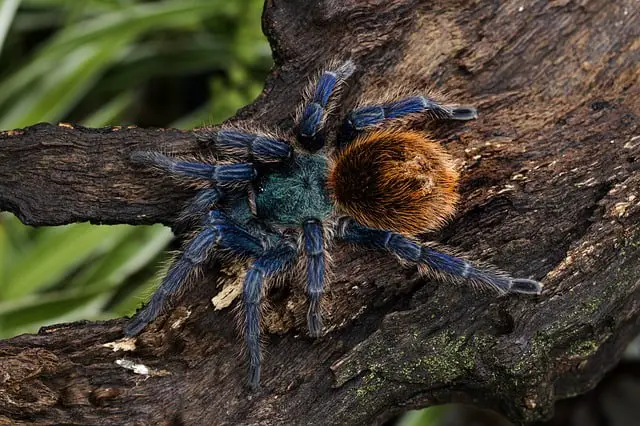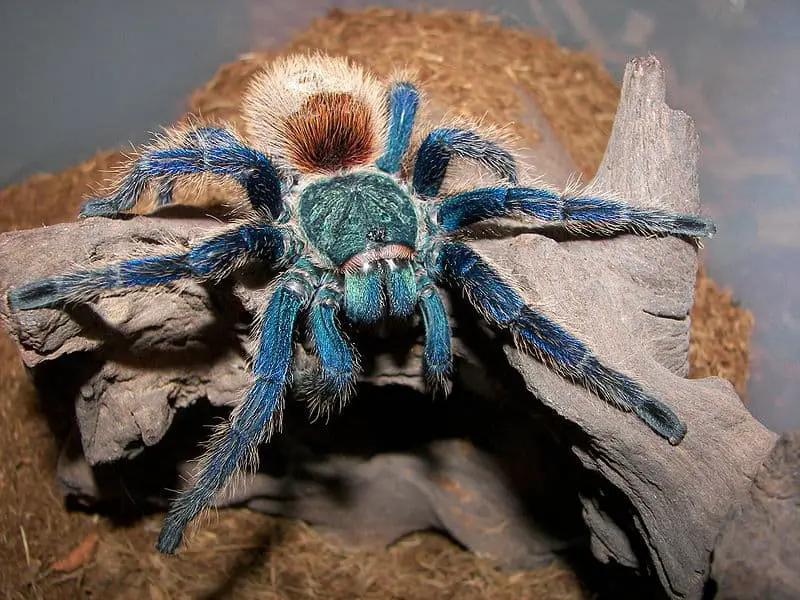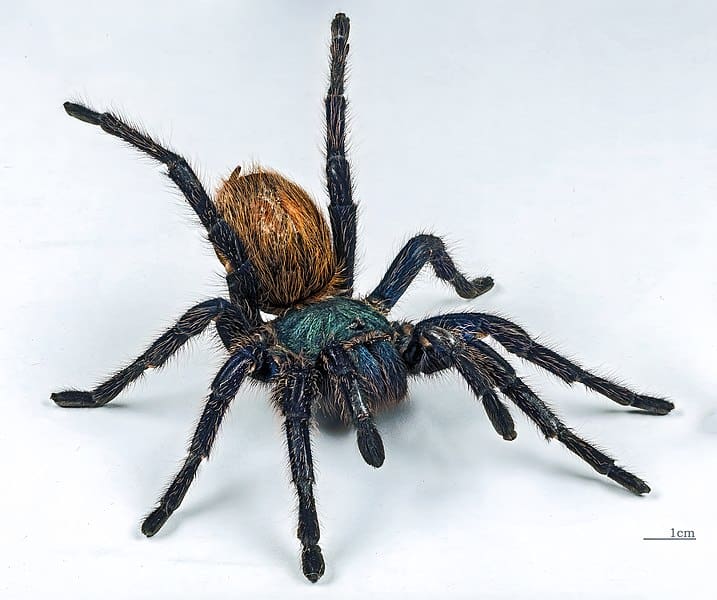The Greenbottle Blue Tarantula (Chromatopelma cyaneopubescens) is a terrestrial New World Tarantula. It is one of the most popular tarantula species among hobbyists due to its docile temperament and beautiful colors.
It gets its name due to its metallic blue legs and green-blueish carapace, giving this spider a unique and highly desired appearance.
The Greenbottle blue is a very popular spider, but finding out if this species is right for you requires some information, which I’m here to provide you with. I will go over everything you need to know about this spider, ranging from their behavior to the care they require. We’ve got a lot to cover, so let’s dig in!

Greenbottle Blue Tarantula Care Sheet
Let’s begin with a quick care sheet. This sheet will give you some of the most important information at a glance.
| Name | Greenbottle Blue Tarantula (GBB) |
| Scientific name | Chromatopelma cyaneopubescens |
| Type | New World |
| Category | Terrestrial |
| Native location | Paraguaná Peninsula, Venezuela |
| Body length | 2.75 inches (7 centimeters) |
| Leg span | 6.25 inches (16 centimeters) |
| Growth rate | Fast |
| Diet | Insects; crickets, grasshoppers, super worms, small roaches. |
| Lifespan | Males up to 4 years, females up to 14 years. |
| Experience | Beginner |
| Humidity | 30-50% |
| Temperature | 70-78 Fahrenheit |
Greenbottle Blue Tarantula Overview
The Greenbottle Blue tarantula is native to Venezuela. More specifically, they’re from the Paraguaná Peninsula. The peninsula has a desert climate, so these are desert tarantulas. They were first described in 1907 by the Norwegian arachnologist Embrik Strand.
Throughout the tarantula’s history, it’s been moved from genus to genus. In 1939 the spider was moved to the newly created Delopelma genus and in 1997 it was moved again to the Chromatopelma genus.
As terrestrial tarantulas, they spend their life on the ground, waiting for prey to ambush.
Appearance

The greenbottle blue tarantula is a stunning spider with a blue-green carapace and metallic blue legs. They’re among the most brightly colored of all the tarantula species which has made them very loved among hobbyists.
The greenbottle blue grows quite fast and fully grown it’s considered a medium-sized tarantula. Their fully grown body length is about 2.75 inches while their leg span is around 4 to 6.25 inches.
Females of this species are larger than males but the sexual dimorphism in this species is not enough to accurately determine whether you have a male or a female on your hand. Instead, you should look at the exoskeleton they leave behind after a molt.
Behavior & Temperament
GreenBottle Blues are typically not very aggressive and do not have a tendency to bite. If you do get bitten, it’s not a huge deal. They do have venom, but this will cause slight irritation at worst and is not threatening to humans.
Rather than their venom, you should be more worried about their urticating hairs. Like all New World Species, this tarantula has urticating hairs that they can kick when they feel threatened or disturbed.
These spiders live in webbed burrows that they create under bushes and tree roots. They use webs to protect the entrance of the burrow against the rough desert climate and as a tripwire to notify them when prey is nearby.
The Greenbottle Blue is okay as a species for beginners but whether it’s right for you depends on what you want to get out of owning a pet tarantula. If you just want to look at it, then this species is an amazing choice. Unlike some other species, they’re very active and spend a lot of time roaming around their enclosure. They spend a lot of their time out in the open giving you ample time to observe them.
However, if you’re a beginner enthusiast and want one that you can handle and hold, they might not be the ideal choice. They’re quite skittish and can be easily scared. When they get scared they can kick their urticating hairs, which can be very painful, and they will often retreat into their hide.
So, if you’re a beginner and are looking for a tarantula to admire from a distance the Greenbottle Blue is a great choice. If you’re looking for a spider that you can handle and hold, it’s better to consider other tarantulas such as the Mexican Red-Knee.
Price
If you’re looking for a Greenbottle blue tarantula for sale you can find them at many online breeders. They typically go for a price of $50 to $75.
Females are often more expensive than males due to their large size and longer lifespan.
Greenbottle Blue Tarantula Care

If you decide that this is the right tarantula species for you, then you need to know how to properly care for them. That includes giving them the right enclosure, the right food, the optimal humidity, and the optimal temperature.
Enclosure
A simple terrestrial cage will suffice for the Greenbottle Blue. It is important that their enclosure has enough ventilation. A plastic critter keeper-style terrarium will work just fine. Their tank should be 5 to 10 gallons. The amount of floor space in their enclosure is more important than the height.
Substrate
These spiders need a dry substrate. Some suggestions for the substrate are:
- Commercial organic cactus soil mix
- 50/50 sphagnum peat moss/vermiculite mix
It is recommended to put a layer of substrate about 4 inches thick into the enclosure.
Retreat/hide
While this particular spider tends to spend a lot of time out in the open it still does need a hide. You can place a piece of bark in the enclosure as a starter retreat. However, the GBB is an avid webber and will most likely create its own retreat from webs.
Humidity
The Greenbottle Blue is a desert spider and for that reason, they thrive in low humidity. They need between 30 and 50% relative humidity in their enclosure. Checking the humidity in their enclosure can be done easily through the use of a hygrometer.
Achieving low humidity can be hard or difficult, depending on where you live. If you live in a place where there’s naturally low humidity then consider yourself lucky because you might not have to worry about humidity at all.
If you live in a humid climate it can be quite tricky to get the humidity low enough to accommodate this desert spider. Make sure that there is proper ventilation and do not mist their cage too often.
Temperature
A temperature of 70 to 78 degrees Fahrenheit is recommended for this spider. If you live in a cold climate it might be necessary to use a heating pad or lamp to ensure that its enclosure reaches the desired temperature.
Feeding
These spiders mainly eat insects. Good insects to feed them are crickets, grasshoppers, super worms, and small roaches. When the GBB is in pre-molt, it will not eat. This is a common behavior among all tarantulas and is nothing to worry about. To learn more about the molting process, check out this molting guide.
Feeding should happen at night/in the evening because just like other tarantulas, the GBB is nocturnal.
Handling
This tarantula is quite skittish, fast, and can easily be startled. For that reason, it’s not recommended that you handle them at all. They’re much better observed from a distance rather than directly handled.
If you do decide to handle them, be very careful. They’re not considered to be very defensive, meaning they usually won’t bite when they’re startled, but they can shoot their urticating hairs at you. Also, they might run off your hand and fall on the floor. Even relatively small falls can do serious damage to a tarantula.
Molting
Every tarantula species molts many times in its life, and so will your Greenbottle blue. You’ll know that it’s about to molt because it will refuse to eat for several days. This is done because it makes it easier for them to shed their old exoskeleton.
During the molt, it’s very important that you do not disturb them. A failed molt can result in lost legs, eyes, or even death.
Once the molt has been completed, refrain from feeding or handling them for a while so that they have time for their exoskeleton to harden.
You should remove the shed exoskeleton from its enclosure.
Communal living
The Greenbottle Blue cannot live communally. They’re solitary spiders that only meet other members of their species during the mating time and even that can end in cannibalism. In captivity, they should be housed solitarily, putting more than one Greenbottle Blue in a single enclosure is a recipe for disaster.
If you’re interested in communal tarantulas, check out the Socotra Blue Baboon or the Trinidad Olive Tarantula instead.
Health & Lifespan
The Greenbottle Blue Tarantula typically has a lifespan of 14 years for females. Males live much shorter at about 4 years.
In captivity, it’s quite easy for them to live out their full lifespan as long as you care for them properly.
The main things to watch out for to keep them healthy are:
- Mold & bacterial growth
- Parasites
- Falls
Mold growth can be prevented by removing uneaten food in a timely matter. In addition, adequate ventilation is important. Some owners also choose to build a bioactive enclosure to help with bacteria and mold growth.
To avoid parasites, make sure that you feed your spider a high-quality diet that consists of captive-bred prey insects. Wild-caught insects should not be fed because they can contain parasites that can spread to your spider.
Lastly, since the Greenbottle blue is a terrestrial spider, falls are a threat to them. Even falls from relatively low heights can do a lot of damage and can even rupture their abdomen. To avoid this, make sure that their enclosure is built in such a way that it does not allow for long-distance falls. Also, if you choose to handle them, be very careful not to drop them.
Facts about the Greenbottle Blue Tarantula
- The Chromatopelma cyaneopubescens was first described in 1907 by Embrik Strand.
- It is the only species in the Chromatopelma genus.
- Females can lay up to 100 eggs after mating
Final words
The Greenbottle blue tarantula is without a doubt one of the most beautiful tarantula species in the world. Their striking colors make them a great addition to any collection.
In addition, the fact that they’re relatively easy to care for and quite docile means that they’re a great species to get your feet wet with for first-time owners!
- How Long Do American Eskimo Dogs Live? Important Factors and Care Tips - September 29, 2023
- Do American Bulldogs Need Grooming? Essential Tips and Care Guidelines - September 29, 2023
- Do Bengal Cats Enjoy Playing? Essential Tips for Keeping Them Active - September 29, 2023